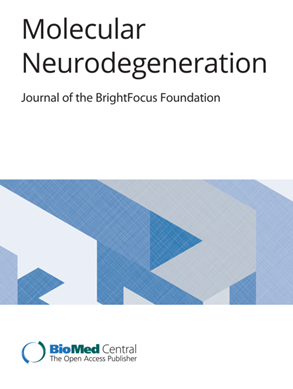Comprehensive cross-sectional and longitudinal comparisons of plasma glial fibrillary acidic protein and neurofilament light across FTD spectrum disorders
IF 17.5
1区 医学
Q1 NEUROSCIENCES
引用次数: 0
Abstract
Therapeutic development for frontotemporal dementia (FTD) is hindered by the lack of biomarkers that inform susceptibility/risk, prognosis, and the underlying causative pathology. Blood glial fibrillary acidic protein (GFAP) has garnered attention as a FTD biomarker. However, investigations of GFAP in FTD have been hampered by symptomatic and histopathologic heterogeneity and small cohort sizes contributing to inconsistent findings. Therefore, we evaluated plasma GFAP as a FTD biomarker and compared its performance to that of neurofilament light (NfL) protein, a leading FTD biomarker. We availed ARTFL LEFFTDS Longitudinal Frontotemporal Lobar Degeneration (ALLFTD) study resources to conduct a comprehensive cross-sectional and longitudinal examination of the susceptibility/risk, prognostic, and predictive performance of GFAP and NfL in the largest series of well-characterized presymptomatic FTD mutation carriers and participants with sporadic or familial FTD syndromes. Utilizing single molecule array technology, we measured GFAP and NfL in plasma from 161 controls, 127 presymptomatic mutation carriers, 702 participants with a FTD syndrome, and 67 participants with mild behavioral and/or cognitive changes. We used multivariable linear regression and Cox proportional hazard models adjusted for co-variates to examine the biomarker utility of baseline GFAP and NfL concentrations or their rates of change. Compared to controls, GFAP and NfL were elevated in each FTD syndrome but GFAP, unlike NfL, poorly discriminated controls from participants with mild symptoms. Similarly, both baseline GFAP and NfL were higher in presymptomatic mutation carriers who later phenoconverted, but NfL better distinguished non-converters from phenoconverters. We additionally observed that GFAP and NfL were associated with disease severity indicators and survival, but NfL far outperformed GFAP. Nevertheless, we validated findings that the GFAP/NfL ratio may discriminate frontotemporal lobar degeneration with tau versus TDP-43 pathology. Our head-to-head comparison of plasma GFAP and NfL as biomarkers for FTD indicate that NfL consistently outmatched GFAP as a prognostic and predictive biomarker for participants with a FTD syndrome, and as a susceptibility/risk biomarker for people at genetic risk of FTD. Our findings underscore the need to include leading biomarkers in investigations evaluating new biomarkers if the field is to fully ascertain their performance and clinical value.血浆胶质纤维酸性蛋白和神经丝光在FTD谱系障碍中的横断面和纵向比较
由于缺乏易感性/风险、预后和潜在致病病理的生物标志物,阻碍了额颞叶痴呆(FTD)的治疗发展。血液胶质纤维酸性蛋白(GFAP)作为FTD的生物标志物已引起人们的关注。然而,对FTD中GFAP的研究受到症状和组织病理学异质性以及小队列规模的阻碍,导致结果不一致。因此,我们评估了血浆GFAP作为FTD生物标志物,并将其与主要FTD生物标志物神经丝光(NfL)蛋白的性能进行了比较。我们利用ARTFL LEFFTDS纵向额颞叶变性(ALLFTD)研究资源,在最大的一系列特征明确的FTD前突变携带者和散发性或家族性FTD综合征的参与者中,对GFAP和NfL的易感性/风险、预后和预测性能进行了全面的横切面和纵向检查。利用单分子阵列技术,我们测量了161名对照组、127名症状前突变携带者、702名FTD综合征患者和67名轻度行为和/或认知改变患者血浆中的GFAP和NfL。我们使用多变量线性回归和校正协变量的Cox比例风险模型来检验基线GFAP和NfL浓度或其变化率的生物标志物效用。与对照组相比,GFAP和NfL在每种FTD综合征中均升高,但与NfL不同的是,GFAP与轻度症状的对照组区别不大。同样,在症状前突变携带者中,基线GFAP和NfL在后来表型转化中都较高,但NfL更好地区分了非表型转化者和表型转化者。我们还观察到GFAP和NfL与疾病严重程度指标和生存率相关,但NfL远优于GFAP。然而,我们证实了GFAP/NfL比值可以区分tau与TDP-43病理的额颞叶变性。我们将血浆GFAP和NfL作为FTD的生物标志物进行了直接比较,结果表明,NfL作为FTD综合征参与者的预后和预测性生物标志物,以及作为FTD遗传风险人群的易感性/风险生物标志物,始终优于GFAP。我们的研究结果强调,如果该领域要充分确定新生物标志物的性能和临床价值,就需要在评估新生物标志物的研究中纳入领先的生物标志物。
本文章由计算机程序翻译,如有差异,请以英文原文为准。
求助全文
约1分钟内获得全文
求助全文
来源期刊

Molecular Neurodegeneration
医学-神经科学
CiteScore
23.00
自引率
4.60%
发文量
78
审稿时长
6-12 weeks
期刊介绍:
Molecular Neurodegeneration, an open-access, peer-reviewed journal, comprehensively covers neurodegeneration research at the molecular and cellular levels.
Neurodegenerative diseases, such as Alzheimer's, Parkinson's, Huntington's, and prion diseases, fall under its purview. These disorders, often linked to advanced aging and characterized by varying degrees of dementia, pose a significant public health concern with the growing aging population. Recent strides in understanding the molecular and cellular mechanisms of these neurodegenerative disorders offer valuable insights into their pathogenesis.
 求助内容:
求助内容: 应助结果提醒方式:
应助结果提醒方式:


